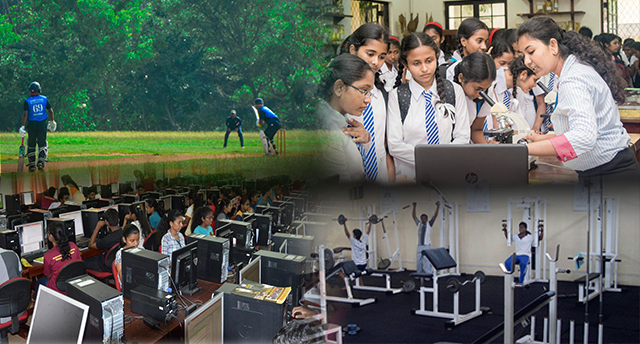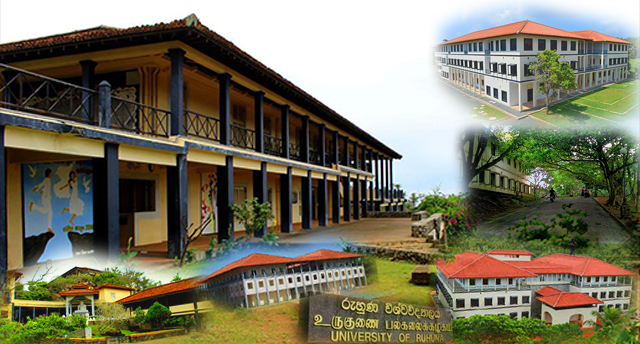History of the University of Ruhuna
The University of Ruhuna, established by a Special Presidential Decree in 1978 and elevated to a fully-fledged university in 1984, is Sri Lanka's sixth oldest University. It is the only University in the country's southern region, with ten faculties spread across three prominent locations. The central campus, which is located in Wellamadama, houses the faculties of Science, Humanities and Social Sciences, Management and Finance, and Fisheries and Marine Sciences & Technology. Agriculture and Technology faculties are located in Kamburupitiya, while Engineering, Medicine, and Allied Health Science faculties are located in Galle. Over the past 43 years, the University of Ruhuna has witnessed tremendous progress and development in the academic, research, and outreach spheres and significant improvements in intellectual and infrastructure resources, emerging as a leader in higher education in Sri Lanka.


Past Chancellors and Vice-Chancellors
Chancellors
- Ven. Paravahera Pannaseeha Mahanayaka Thero
- Ven. Aththudawe Sri Rahula Mahanayake Thero
- Ven. Athi pujya Rajakiya Panditha Pallaththara Sri Sumanajothi Thero
- Ven. Dr. Akuratiye Nanda Thero (Current Chancellor)
Vice-Chancellors
- Prof. G. P. Samarawickrama
- Prof. S. Pinnaduwage
- Prof. Chandrasiri Niriella
- Prof. Ranjith Senaratne
- Prof. Susirith Mendis
- Prof. Gamini Senanayake
- Prof. Sujeewa Amarasena
- Prof. P.A. Jayantha (Current Vice Chancellor).
1977 - The government of Sri Lanka appointed a committee headed by Prof. M. B. Ariyapala to do a feasibility study on the establishment of a university in the Southern Province.
1978 - The committee recommended Matara, the Commercial Capital of Sri Lanka's Southern Province, as the best location for the purpose. The same year, a special presidential decree established Ruhuna University College, which was inaugurated by then Prime Minister J.R. Jayawardene at Meddawatta, Matara, with Prof. Mervyn W. Thenabadu as its Director.
At its inception, the college consisted of only four faculties: Agriculture, Humanities and Social Sciences, Medicine, and Science. The Faculty of Humanities and Social Sciences was housed at the Teachers' Training College in Eliyakanda, while the Faculties of Science and Agriculture were located at the Junior Technical College in Meddewatta, Matara, with a staff of approximately 40 academics, 50 non-academics, and 275 students.
1984 - The Ruhuna University College was upgraded to a fully-fledged university on 1st February 1984 by an order made by the Minister of Education under sections 21 and 21(1) of the Universities Act. No. 16 of 1978 published in the gazette extraordinary dated 24 January 1984 in terms of section 27(2) of the Act. The Ruhuna University College was then relocated to Wellamadama, two kilometers from Matara on the Matara-Kataragama main road.


1985 - The General Administration Offices and the Humanities and Social Sciences and Science Faculties were relocated to the Wellamadama premises. At the inception, the Faculty of Science functioned with only five departments: Botany, Chemistry, Physics, Mathematics, and Zoology, while the Faculty of Humanities & Social Sciences with four departments: Sinhala, History, Economics, and Geography.
Under the direction of world-renowned architect Geoffrey Bawa, the new building complex for the University was designed. Edward Reed & Beg Company designed the buildings, while the Ballast Nedam Company of the Netherlands continued the construction at three sites: Wellamadama, Mapalana, and Karapitiya, with a unique architectural landscape.
1997 - To develop distance education programs, the University established an External Examinations Division at Bibulawela, Kamburupitiya, and the same year it was shifted to Wellamadama.
2000 - Her Excellency, the President Chandrika Bandaranayeka Kumaranatunga, inaugurated the Faculty of Engineering, which was constructed at the cost of Rs. 600 million at Hapugala, Galle.
1985 - The General Administration Offices and the Humanities and Social Sciences and Science Faculties were relocated to the Wellamadama premises. At the inception, the Faculty of Science functioned with only five departments: Botany, Chemistry, Physics, Mathematics, and Zoology, while the Faculty of Humanities & Social Sciences with four departments: Sinhala, History, Economics, and Geography.
Under the direction of world-renowned architect Geoffrey Bawa, the new building complex for the University was designed. Edward Reed & Beg Company designed the buildings, while the Ballast Nedam Company of the Netherlands continued the construction at three sites: Wellamadama, Mapalana, and Karapitiya, with a unique architectural landscape.
1997 - To develop distance education programs, the University established an External Examinations Division at Bibulawela, Kamburupitiya, and the same year it was shifted to Wellamadama.
2000 - Her Excellency, the President Chandrika Bandaranayeka Kumaranatunga, inaugurated the Faculty of Engineering, which was constructed at the cost of Rs. 600 million at Hapugala, Galle.


2003 - Faculty of Management and Finance was established initially with two departments. Previously, Business Administration study programs were offered by the Department of Business Administration, which was part of the Faculty of Humanities and Social Sciences.
In the same year, To centralize and promote postgraduate studies in all faculties, an independent body was established with Prof. Morley De Silva as Director.
2011- The University Grants Commission approved the proposal forwarded by the University of Ruhuna to establish the Faculty of Graduate Studies as the 8th Faculty in Ruhuna University. The official inauguration of the Faculty of Graduate Studies and opening of the Faculty office at Wellamadama administrative complex took place on 8th December.
2012/2013 -The University of Ruhuna was awarded a special commendation at the National Productivity Awards under the large-scale service sector and a special commendation for inter-department at the National Productivity Awards in 2015. Further, the University's academics have secured first and fifth places at the National Science Awards Ceremony in 2016.
2015- A Memorandum of Understanding (MoU) for constructing the Rabindranath Tagore Memorial Auditorium at the University of Ruhuna was signed between India and Sri Lanka. The project was an India-Sri Lanka Development Partnership Project with Indian grant assistance of Rs. 300 million.
2016 - The Faculty of Technology was officially established as the University of Ruhuna's ninth Faculty through a gazette notification issued on 26.04.2016. The new Faculty complex was located near the Faculty of Agriculture in Kamburupitiya. The Faculty offers four-year degree programs specializing in Engineering Technology, Information and Communication Technology, and Bio-Systems Technology from departments specializing in these fields.
2017- The Faculty of Allied Health Sciences (FAHS) of the University of Ruhuna was established in September 2017. Initially, it was started in the Faculty of Medicine as Allied Health Sciences Degree Programme (AHSDP) to provide undergraduate studies in the disciplines of Medical Laboratory Science and Nursing in 2008 and Pharmacy in 2010.
According to Elsevier, Scopus 2017, the University of Ruhuna contributed a percentage of 25.9 in publications in the top 10% most cited worldwide and 48.6% in publications in the top 10% journals by CiteScore Percentile in Sri Lanka from 2014 to 2016. In terms of research output, the University of Ruhuna ranked first among Sri Lanka's national universities. The Sri Lanka Elsevier Research Forum 2017 was named "The Scopus most prolific Sri Lankan University" based on its outstanding research output from 2011 to 2016.
2018 – The construction of Rabindranath Tagore Memorial Auditorium was completed and was inaugurated by President Maithripala. The state-of-the-art auditorium, with a 1500 seating capacity, is the largest in any of the universities in Sri Lanka. The auditorium is designed to conform to the philosophy of "Tropical Modernism" by famous Sri Lankan Architect Geoffrey Bawa, equipped with all the modern facilities.
